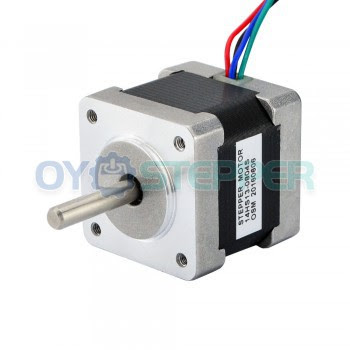NEMA 14 Frame Size(35 x 35mm)
1.8° Step Angle
High Torque - Up to 56.6 oz-in
High Step Accuracy and Resolution
Low Vibration and Noise
CE Certified and RoHS
Can be Customized for
-Winding Current
-Shaft Options
-Cables and Connectors
Typical Applications of 14 Stepper Motor: Inject printers, Analytical and Medical Instruments, High Speed Dome Camera, Textile Equipment, Precision Telescope Positioning Systems, Embroidery Machine and Robotics
cnc stepper motor/step motor/stepper motor/Stepper Motor
The 14HS13-0804S Stepper Motor was developed primarily for users who have a restricted installation depth available and where a stepper motor with a construction size of 28 mm Stepper Motor is too long and a construction size of 39 mm Stepper Motor is too big. With the highest possible torque the Nema 14 Stepper Motor for sale series offers a high resolution and is deployed with low-priced power drive for applications in the precision device construction. We have 8-Lead Stepper Motor that can be connected in all possible configurations: series, unipolar, or parallel, to allow the maximum flexibility for your application. We can also customize Nema 14 Stepper Motor's winding to perfectly match voltage, current, and maximum operating speed to meet your requirements.
Need help choosing the right Stepper Motor? Read this: Uni-polar vs Bi-polar or learn more about Stepper Motor Basics.
1.8° Step Angle
High Torque - Up to 56.6 oz-in
High Step Accuracy and Resolution
Low Vibration and Noise
CE Certified and RoHS
Can be Customized for
-Winding Current
-Shaft Options
-Cables and Connectors
Typical Applications of 14 Stepper Motor: Inject printers, Analytical and Medical Instruments, High Speed Dome Camera, Textile Equipment, Precision Telescope Positioning Systems, Embroidery Machine and Robotics
cnc stepper motor/step motor/stepper motor/Stepper Motor
The 14HS13-0804S Stepper Motor was developed primarily for users who have a restricted installation depth available and where a stepper motor with a construction size of 28 mm Stepper Motor is too long and a construction size of 39 mm Stepper Motor is too big. With the highest possible torque the Nema 14 Stepper Motor for sale series offers a high resolution and is deployed with low-priced power drive for applications in the precision device construction. We have 8-Lead Stepper Motor that can be connected in all possible configurations: series, unipolar, or parallel, to allow the maximum flexibility for your application. We can also customize Nema 14 Stepper Motor's winding to perfectly match voltage, current, and maximum operating speed to meet your requirements.
Need help choosing the right Stepper Motor? Read this: Uni-polar vs Bi-polar or learn more about Stepper Motor Basics.





